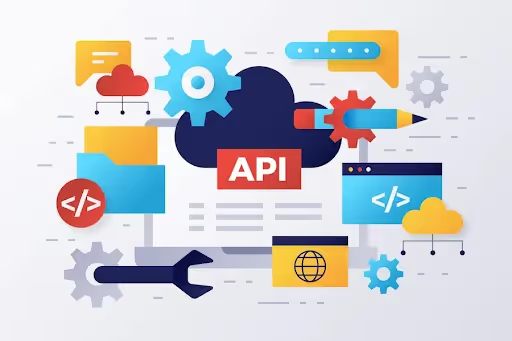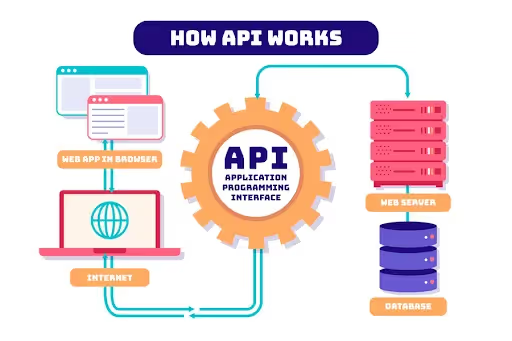If you are ready to enhance your web design with expert solutions, let’s talk!
The world of Fintech is diverse and multifaceted, and APIs are the little workers helping it become more interconnected than ever. API in Fintech powers payment processing and verification, data sharing and aggregation, and more.
By 2029, the number of API calls is expected to explode from 137 billion in 2025 to a massive 722 billion. That’s a 427% jump! And it’s not just about activity. Money’s moving too. The value of open banking transactions is set to soar, reaching $330 billion by 2027.
So, if you consider creating or improving your app, that’s the right place to get more useful info.
Arounda has made multiple Fintech applications a reality, so today, we’ll share our experience in harnessing the power of Fintech APIs. Below, you’ll find the answers to the four most common questions about this technology:
- Fintech API: what is it, and how does it work?
- How does it work?
- What are the benefits of using Fintech APIs?
- How are Fintech APIs applied in the finance and banking industry?
Fintech API: What Is It?

An application programming interface (API) is a piece of code that allows two programs to exchange information and, in some cases, certain functionality. For example, when you need to add a third-party integration to your app, an API makes it possible.
As for the API meaning in Fintech, in particular, Fintech APIs are the APIs that connect a financial app with service providers.
For example, payment processing companies like PayPal and Stripe have their APIs to help developers integrate new apps with them. Banks, credit card companies, investment firms, and cryptocurrency exchanges can offer their APIs.
Why Do APIs Exist?
Fintech API: what is it based on? Why can’t applications interact directly without an API? There are two main reasons:
- Diverse tech stacks. Your personal finance app is written in Python, while the banking system operates using Java. It’s akin to one person speaking German and the other one – Chinese. They can’t communicate without an interpreter. APIs are exactly that: the middleware that interprets requests and responses.
- Security risks. APIs conceal the internal details of how a system operates. As a result, they limit what developers and end users can get their hands on. Without them, internal logic is exposed to significant risks: sensitive data can be stolen or corrupted, for example.
How Do Fintech APIs Work?
Imagine you’re using a personal finance app online. You want it to automatically add all of your bank transactions to the app. Once you click on the “Connect your bank account” button, here’s what happens:
1. The app connects with the API over the internet and uses it to “translate” the request and send it where appropriate.
2. The API calls on a specific endpoint established by the bank on one of its servers. This endpoint receives the request and sends out an authentication request.
3. You enter your authentication details and click “Submit.” The app sends them to the bank’s server via the API. There, it gets compared with the database.
4. If your details are correct, the server approves the request.
5. Now, every time you have a new financial transaction in your bank account, it’ll be automatically sent to the personal finance app.

What Are the Benefits of Using APIs in Fintech & Banking?
Did you know that 75% of new fintech products use Open Banking APIs to boost functionality? And these four benefits are the reasons why.
Accelerated Time-to-Market
If there were no APIs, developers would have to write similar code for every Fintech and banking app they created. And they’d have to do it for every third-party integration, too. That, as you can imagine, would increase the development time two- to threefold.
With APIs, developers can just add them as building blocks into the code with a couple of lines – and refer to them as easily. That means using API in Fintech abridges time-to-market for any project that involves third-party integrations.
Reduced Development Costs
Since the project timeline is shorter if developers use APIs, your development costs will be lower, too. Your total budget can be reduced by around $40 for every development hour saved. And since APIs save dozens of hours of work, you can cut your costs by thousands of dollars.
There’s one sidenote, however: most Fintech APIs aren’t free to use. Of course, prices will differ on your call volume and the number of APIs. But to give you an idea, Plaid offers a set of Fintech APIs under its custom plan starting at $500 per month.
Secure Data Exchange
The beauty of APIs is that they don’t reveal how the called-on program functions under the hood. They limit what variables and functions developers can use. In Fintech and banking, it allows for more solid data security across the industry.
That’s not to say APIs are always 100% secure. Oneethical hack revealed that all 55 Fintech mobile apps tested sent out traffic via APIs that could be intercepted and decrypted.
Ergo, if API developers don’t follow the Fintech API standards to a T, their creations can contain potentially devastating exploits. Those include:
- Authorization errors
- Broken authentication or access control
- SQL injections
- Security misconfiguration
- Components with known vulnerabilities
Improved User Experience
Third-party integrations make users’ lives easier, thus improving their user experience. Would they prefer to use their American Express card in your money transfer app? They’ll be glad to see you support it. Do they have a PayPal account they’d like to use during checkout? You better have them covered.
Fintech and banking APIs are also behind features that save users’ time. Syncing bank transactions with a personal finance app is a good example here. Instead of adding all transactions manually, the user needs to authorize data sharing – and the app does the rest for them.
How Does the Fintech and Banking Sector Use APIs?
Fintech APIs come in many flavors when it comes to their purpose. Let’s break down four use cases for them, along with real-world Fintech API examples.
Payment & Withdrawal Processing
Any application involving online payments or debit or credit card payouts requires a Fintech API. It can be an online store like Zappos, a subscription-based service like Spotify, or a finance application like Robinhood.
For example, when we weredeveloping Gigzi, a blockchain-powered wealth management platform, we also had to turn to Fintech APIs. Without them, we wouldn’t have been able to allow Gigzi users to add their debit and credit cards to the platform and deposit and withdraw their funds.
Here are four examples of payment processing APIs:
- PayPal
- Stripe
- BrainTree
- MangoPay
Payment processing APIs have to support Know Your Customer (KYC) identity verification, encryption, and fraud detection to ensure data security. They should also handle currency exchanges, invoicing, automatic payments, and payouts.
Investment & Trading
In this sector of the finance industry, Fintech APIs are behind consolidating and processing stock market historical and real-time information. This data can then be used to make predictions with a proprietary algorithm.
Fintech APIs can also allow users to trade various assets from one centralized platform on multiple exchanges. Plus, they can centralize the data on various account types held by banks, brokerages, and retirement plan providers.
Investment and trading APIs include:
- Marketstock
- Finnhub
- Barchart
- Alpha Vantage
Banking Integration
If you want to allow your users to add their banking information to your application, you can’t do without Fintech APIs.
This can come in handy in B2C personal budgeting and finance management apps. Any bank app that offers integrating other banks’ accounts also relies on APIs to do so.
In the B2B segment, banking APIs power aggregating financial information in bookkeeping and payroll software. Other use cases include facilitating B2B invoicing, multi-currency and multi-bank expense management, and financial analysis.
Here are three examples of Fintech APIs that power banking integration:
- Plaid
- Syncfy Connect
- Yodlee
Blockchain & Cryptocurrency
Much like stock trading, the blockchain world includes multiple asset types and exchange platforms. APIs can integrate them under one user interface. They can also aggregate cryptocurrency exchange rates or add multiple wallets to an app.
Blockchain APIs facilitate implementing smart contracts, too. These smart contracts use blockchain to automatically execute the contract when certain conditions are met.
Smart contracts can be created on multiple platforms (Binance Smart Chain, Polkadot, Avalanche, etc.). APIs are used for aggregating them in one place. They can also help track and log events in the external world (e.g., the UPS status change from “on the way” to “delivered”).
APIs will also come in handy if you want to allow users to choose Bitcoin or a different cryptocurrency as a payment method.
Blockchain APIs include:
- Blockchain’s Exchange
- Coinbase
- Bitquery
Final Thoughts: What Does the Future Hold for Fintech APIs?
API’s Fintech meaning can’t be underestimated. Without these pieces of code, a rare Fintech app would be able to deliver an outstanding and secure user experience – nor would it be more affordable and faster to develop.
Fintech APIs power everything from online payments and withdrawals to multi-exchange stock trading and bookkeeping. They’re also used to aggregate banking information from multiple sources and easily integrate cryptocurrencies into apps.
It’s safe to say Fintech APIs aren’t going anywhere anytime soon. If anything, their adoption will only accelerate, as corroborated by McKinsey’s projections.
Don’t want to miss out on the financial opportunity that Fintech APIs represent? If so, Arounda is here to help you out. Thanks to our extensive experience in the field, we know all the ins and outs of using APIs in Fintech software. Our Gigzi case study is just one testament to our expertise.
Ready to discuss your project? Drop us a line – and we’ll get right back to you.














